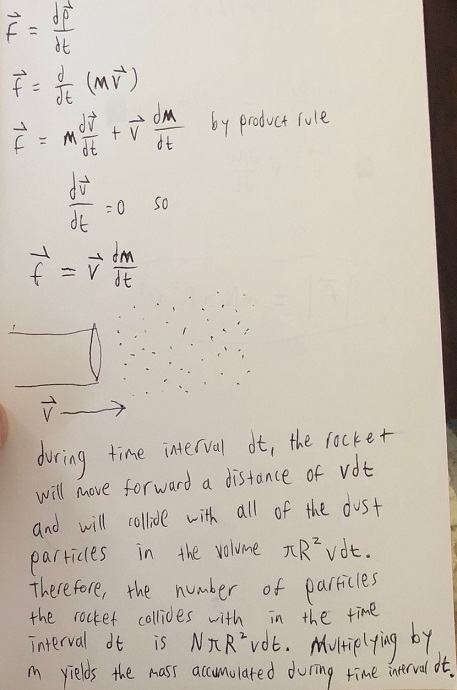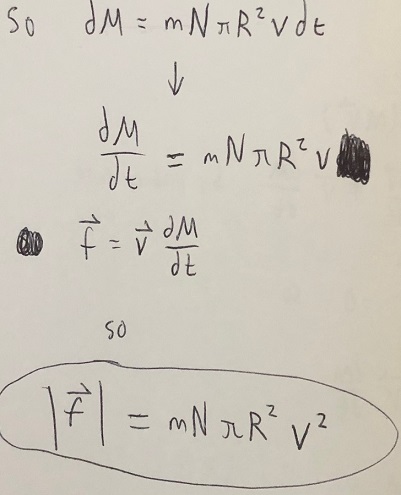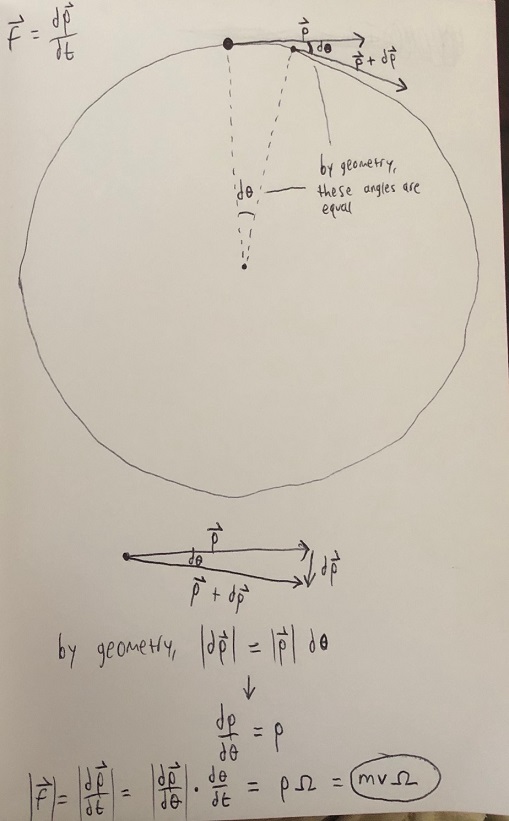Newton's Second Law: the Momentum Principle: Difference between revisions
No edit summary |
|||
| Line 4: | Line 4: | ||
Newton's second law, also known as the momentum principle, states that <math>\vec{F}_{net} = \frac{d\vec{p}_{system}}{dt}</math> where <math>\vec{p}</math> is the [[linear momentum]] of a system, <math>\vec{F}_{net}</math> is the net external force acting on the system from its surroundings, and t is time. Often, the system in question consists of a single particle whose motion we want to predict. Note that both force and momentum are vector quantities, and that the change in momentum as a result of a force will always be in the direction of that force. | Newton's second law, also known as the momentum principle, states that <math>\vec{F}_{net} = \frac{d\vec{p}_{system}}{dt}</math> where <math>\vec{p}</math> is the [[linear momentum]] of a system, <math>\vec{F}_{net}</math> is the net external force acting on the system from its surroundings, and t is time. Often, the system in question consists of a single particle whose motion we want to predict. Note that both force and momentum are vector quantities, and that the change in momentum as a result of a force will always be in the direction of that force. | ||
Here are some simple situations to help you build an intuition for the momentum principle: | |||
<ol> | |||
<li>If a particle travels in a straight line at a constant speed, its momentum is constant, so there is no net force acting on the particle. | |||
<li>If a particle travels in a straight line while speeding up, its momentum is increasing, so there must be a net force acting in the same direction as the particle's momentum. | |||
<li>If a particle travels in a straight line while slowing down, its momentum is decreasing, so there must be a net force acting in the opposite direction as the particle's momentum. | |||
<li>If a particle travels along a curving path, its momentum changes direction, and a force not parallel to the object's momentum must be acting on it. | |||
</ol> | |||
The momentum principle has no derivation, as it is considered the definition of force. | The momentum principle has no derivation, as it is considered the definition of force. | ||
Revision as of 10:31, 23 May 2019
This page describes Newton's second law, also known as the momentum principle, which relates net force to the change in linear momentum. This principle is used to predict the effects of forces on the motion of objects.
The Main Idea
Newton's second law, also known as the momentum principle, states that [math]\displaystyle{ \vec{F}_{net} = \frac{d\vec{p}_{system}}{dt} }[/math] where [math]\displaystyle{ \vec{p} }[/math] is the linear momentum of a system, [math]\displaystyle{ \vec{F}_{net} }[/math] is the net external force acting on the system from its surroundings, and t is time. Often, the system in question consists of a single particle whose motion we want to predict. Note that both force and momentum are vector quantities, and that the change in momentum as a result of a force will always be in the direction of that force.
Here are some simple situations to help you build an intuition for the momentum principle:
- If a particle travels in a straight line at a constant speed, its momentum is constant, so there is no net force acting on the particle.
- If a particle travels in a straight line while speeding up, its momentum is increasing, so there must be a net force acting in the same direction as the particle's momentum.
- If a particle travels in a straight line while slowing down, its momentum is decreasing, so there must be a net force acting in the opposite direction as the particle's momentum.
- If a particle travels along a curving path, its momentum changes direction, and a force not parallel to the object's momentum must be acting on it.
The momentum principle has no derivation, as it is considered the definition of force.
A Mathematical Model
The momentum principle states that [math]\displaystyle{ \vec{F}_{net} = \frac{d\vec{p}}{dt} }[/math]. Recall that [math]\displaystyle{ \vec{p} = m\vec{v} }[/math]. Therefore, by product rule, [math]\displaystyle{ \frac{d\vec{p}}{dt} = m\frac{d\vec{v}}{dt} + \vec{v}\frac{dm}{dt} }[/math]. Usually,the mass of the particle or system is constant over time, so the second term becomes 0, and the momentum principle becomes [math]\displaystyle{ \vec{F}_{net} = m\frac{d\vec{v}}{dt} }[/math], or [math]\displaystyle{ \vec{F}_{net} = m\vec{a} }[/math], which may be a more familiar form of Newton's second law. The form [math]\displaystyle{ \vec{F}_{net} = \frac{d\vec{p}}{dt} }[/math] is preferred for several reasons:
- When a particle accumulates mass that was initially at rest, such as a snowball rolling downhill, the term [math]\displaystyle{ \vec{v}\frac{dm}{dt} }[/math] is not 0, and [math]\displaystyle{ \vec{F}_{net} = m\vec{a} }[/math] is no longer accurate, while [math]\displaystyle{ \vec{F}_{net} = \frac{d\vec{p}}{dt} }[/math] is;
- As a particle approaches the speed of light, [math]\displaystyle{ \vec{F}_{net} = m\vec{a} }[/math] is no longer accurate, while [math]\displaystyle{ \vec{F}_{net} = \frac{d\vec{p}}{dt} }[/math] is, as long as relativistic momentum is used; and
- [math]\displaystyle{ \vec{F}_{net} = \frac{d\vec{p}}{dt} }[/math] has a more direct rotational analogue- that is, it will be easier to accurately learn rotational physics if you learn linear physics using this form.
That said, the relation [math]\displaystyle{ \vec{F}_{net} = m\vec{a} }[/math] can often be of use when the particle is known to have a constant mass and travel at non-relativistic speeds, particularly in combination with kinematic equations that also use [math]\displaystyle{ \vec{a} }[/math] (see kinematics).
The momentum principle is responsible for the relationship between impulse and momentum.
Note that according to the momentum principle, when the external force on a system is 0 (that is, the system is closed), the rate of change of its momentum is 0. This results in Conservation of Momentum in certain situations.
Examples
1. (Simple)
At t=0, a 4kg particle is released from rest and a constant 12N force begins acting on it. How far way is the particle after 5 seconds?
For this problem, it is easier to use [math]\displaystyle{ \vec{F}_{net} = m\vec{a} }[/math] than [math]\displaystyle{ \vec{F}_{net} = \frac{d\vec{p}}{dt} }[/math] because it allows us to solve for [math]\displaystyle{ \vec{a} }[/math] which can then be used in a kinematic equation. We know this form of Newton's second law is accurate for this problem because the particle travels at non-relativistic speeds and is of constant mass.
[math]\displaystyle{ \vec{F}_{net} = m\vec{a} }[/math] can be rearranged into [math]\displaystyle{ \vec{a} = \frac{\vec{F}_{net}}{m} }[/math]
[math]\displaystyle{ a = \frac{12}{4} = 3 }[/math] (direction doesn't matter for this problem.)
[math]\displaystyle{ x_f = \frac{1}{2}at^2 + v_it + x_i = \frac{1}{2}(3)(5^2) = \frac{75}{2} }[/math]
2. (Intermediate)
A cylindrical rocket ship of mass [math]\displaystyle{ M }[/math] and speed [math]\displaystyle{ v }[/math] is cruising through outer space when it encounters a stationary dust cloud. The dust cloud has a number density of [math]\displaystyle{ N }[/math] particles per unit volume, and each dust particle has a mass of [math]\displaystyle{ m }[/math]. The rocket ship has a sticky surface on its front face that allows it to accumulate all of the dust that it hits, absorbing it into its mass. The radius of the rocket ship's circular face is [math]\displaystyle{ R }[/math]. What force does the rocket's thruster need to exert on it in order to preserve its speed as it moves through the dust cloud? (Assume that the consumption of fuel has a negligible impact on the mass of the rocket.)
Advanced Note: in order to use [math]\displaystyle{ \frac{dm}{dt} }[/math] for the accumulation of mass, the accumulated mass (i.e. the dust) must initially be at rest, like in the above problem. Otherwise, one must treat the accumulation of dust particles as a series of collisions, or change one's frame of reference so that the accumulated mass is initially at rest.
3. (Difficult)
A particle of mass [math]\displaystyle{ m }[/math] and speed [math]\displaystyle{ v }[/math] moves in a circular path. Its angular frequency is [math]\displaystyle{ \Omega }[/math]. (Angular frequency is the rate at which the angle of the particle's position is changing in radians per unit time.) Using the momentum principle, show that
a) a nonzero net force is acting on the particle,
b) the magnitude of the force is given by [math]\displaystyle{ f = mv\Omega }[/math], and
c) the direction of the force is inwards towards the center of the circle.
a) The particle's momentum vector is changing over time; its magnitude is constant (mv), but its direction changes as its position along the circular path changes. It is always tangential to the circular path. Since [math]\displaystyle{ \vec{p} }[/math] changes over time, a nonzero net force must be acting on the particle. In fact, the only way a particle of constant mass can have a net force of 0 acting on it is if it is travelling along a straight line at a constant speed, or if it is at rest.
b)
c) As one can see from the diagram above, [math]\displaystyle{ d\vec{p} }[/math] is pointing towards the center of the circle. If the particle is exactly at the top of the circle, its momentum is to the right (or left if the particle is travelling counterclockwise), and as [math]\displaystyle{ d\theta }[/math] approaches 0, [math]\displaystyle{ d\vec{p} }[/math] approaches a downward direction, which is towards the center of the circle.
For more information, see Centripetal Force and Curving Motion. Our answer agrees with the formulas given on that page.
Connectedness
History
See also
Further reading
RANKINE, William John Macquorn, and Edward Fisher BAMBER. A Mechanical Text Book. 1873. Print.
External links
- nhttp://homepages.engineering.auckland.ac.nz/~pkel015/SolidMechanicsBooks/Part_III/Chapter_3_Stress_Mass_Momentum/Stress_Balance_Principles_02_The_Momentum_Principles.pdf
- http://acme.highpoint.edu/~atitus/phy221/lecture-notes/2-2-momentum-principle.pdf
References
- William, Harris. "How Newton's Laws of Motion Work" 29 July 2008. HowStuffWorks.com. <https://science.howstuffworks.com/innovation/scientific-experiments/newton-law-of-motion.htm> 11 April, 2018.
- Sherwood, Bruce A. "2.1 The Momentum Principle." Matter & Interactions. By Ruth W. Chabay. 4th ed. Vol. 1. N.p.: John Wiley & Sons, 2015. 45-50. Print. Modern Mechanics. 8 April, 2018.
- http://www.physicsclassroom.com/class/newtlaws/Lesson-3/Newton-s-Second-Law
- Dugas, René (1988). A history of mechanics. Translated into English by J.R. Maddox (Dover ed.). New York: Dover Publications.
- Jennings, John (1721). Miscellanea in Usum Juventutis Academicae. Northampton: R. Aikes & G. Dicey.


